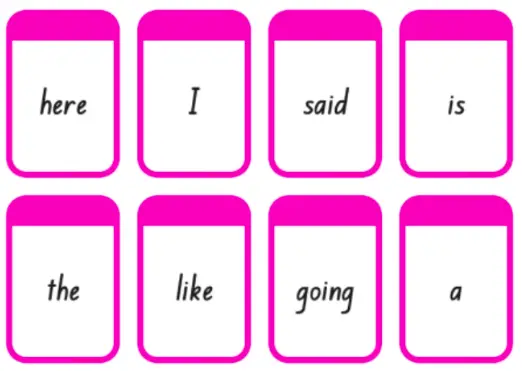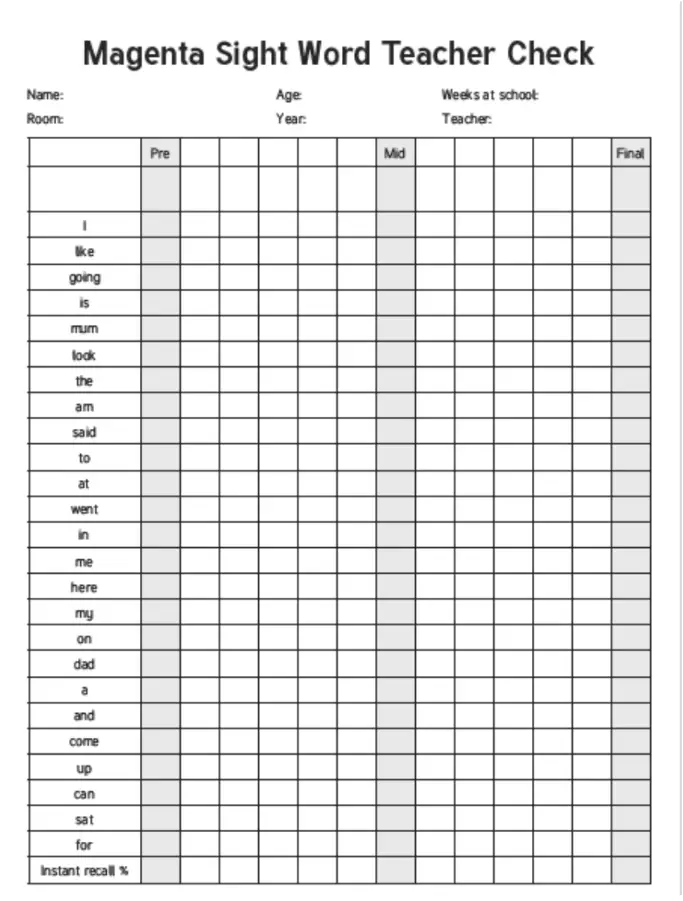Learning to read and write can be an exciting part of starting school for a 5
year old! It feels like you’re a big kid when you can recognize words in a book and write some down all by yourself.
Sometimes though, these things can be a bit challenging for some and we need to find ways for these children to have success. I have found repetition and presenting the learning in a fun way has been most successful.
Also, explaining to the children why they are learning these words. E.g. We are learning these words so that when it comes to writing time you will be able to use them.
Teaching my class to read
Recently in my class of 5 year olds I have been working with a group who needed a boost with their sight word recognition to help their reading progress and some spelling work so that they could attempt to write independently.
I started out by doing assessment on the group to see where they were at.
The results were varied so I went about individualizing the program for each child.
I set up a routine for each lesson as follows:
Sight Word Flashcards
I used the fantastic downloadable set of Magenta level sight word flashcards from Twinkl.com

Sight Word Checklist
This checklist mostly corresponds to the flashcards – ideally it would exactly match.
Each time the child gets a word correct they keep the card and I tick the word. The children found it really motivating to see a tick and wanted to learn the remaining words to get more ticks.
At the end of the flashcards the children counted up how many cards they had and then got house points e.g. 5 words = 5 house points.
A fun competitive team spirit always keeps things engaging for the class!

Online Sight Word Tools
Check out our sight word resource here on Teachers Notepad – the first one we’ve built is a random dolch sight word learning tool which has all the Dolch Sight Word lists to choose from, and an adjustable word display time, which you can load up on your laptop, put on a monitor fullscreen, or simply view on a tablet.
You can even print out a pdf of the word list following the same randomized order, each time you load a new sight words list. This helps keep things interesting for the kids, and prevents them simply memorizing the specific order of the words.
Spelling
I used the NZCER Essential Lists for my spelling program.
The aim was to get the children independently spelling the words from list 1 (a, I, it, the, was, and, in, my, to, we) – as these were often the words they
wanted to use in their writing.
We then set out on our mission to master these sight and spelling words!
Each day the children completed their flashcards with me and then spent time working on their spelling. I created a sheet for them with all the words on it and once they had mastered the word they coloured it in.
This was very motivating for the children as they could see their progress and once they got 10/10 they could choose something from our prize box and move up to List 2!
They then focused on the remaining words and learned them by doing a whole range of other activities…
Help teach reading and writing the simplest way
- Rainbow writing – using different coloured pens or crayons to write the words out.
- Playdough – making the letters needed for the word with playdough.
- Letter tiles – plastic letter tiles, the children can locate the letters needed then make the word.
- Mini whiteboards – writing the words on the whiteboards, rubbing off and writing again.
- Making it fun – chanting the words, hiding the words written on cards for the children to find around the room, using chalk or water outside to write the words down, writing letters on stones and having the children create words with these.
These activities can also be set up as stations for the children to work on during reading and writing times when they are not working with the teacher.
Each child has their own book for these activities and I update the words they are working on each week so they know which words to focus on.
So what about writing time?
When it came to writing time the children were encouraged to use the words that they have been learning.
At the end of each writing session they used a yellow crayon to highlight words from Essential list 1 that they had used.
The children’s confidence to attempt writing has really improved and they are now getting started more quickly and writing a sentence!
Student feedback has been positive with one reluctant student telling me
“I can write, I know that word!”
Reading and Writing teaching methods that I see working
I have found that working on these words each day with the group has meant they have made significant progress.
Two children in particular are often writing two sentences, and consistently use the words they have learned, where as previously they wouldn’t attempt to write at all.
And isn’t that what this is all about – bringing the joy of reading and writing to every child!

